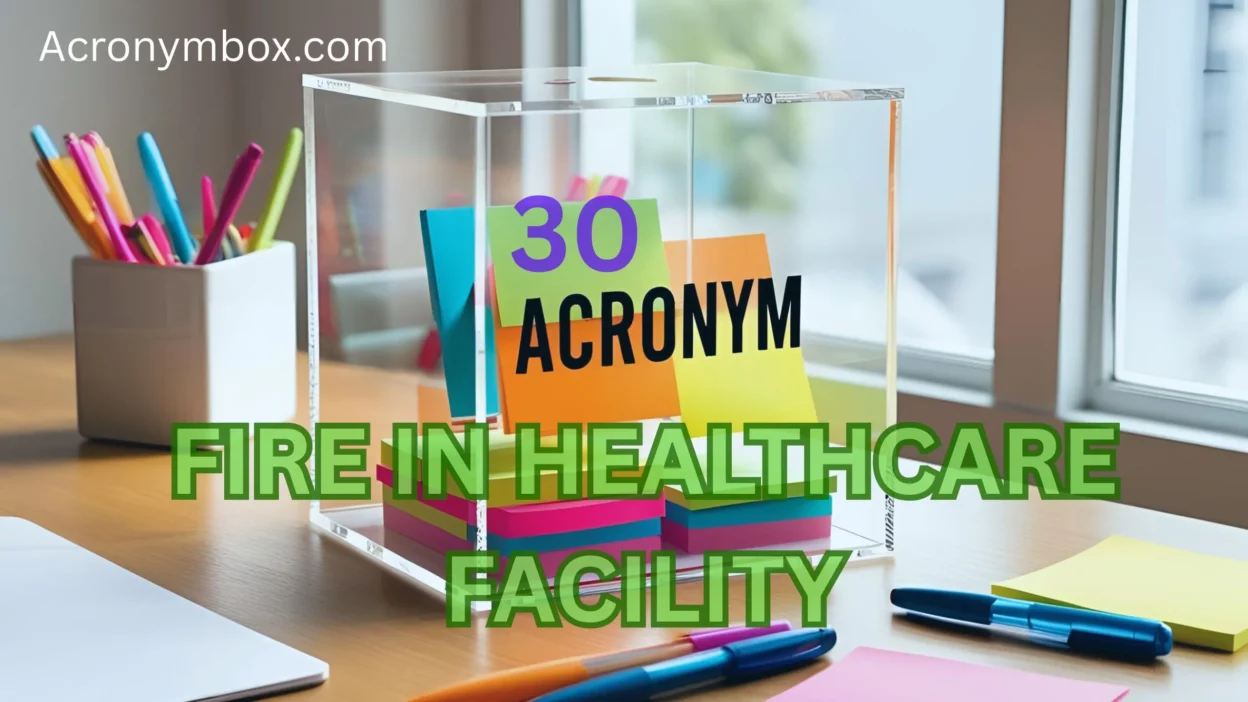In a high-stakes environment like a healthcare facility, every second counts—especially during emergencies. That’s where acronyms like FIRE come into play: they serve as quick-response memory tools to guide staff and patients during a fire outbreak.
But what exactly does “fire in healthcare facility acronym” mean?
Traditionally, FIRE in this context is used to train healthcare personnel on how to act swiftly and safely when a fire breaks out within a hospital, clinic, or care center. One of the most commonly taught breakdowns of FIRE is:
- F – Find the fire
- I – Initiate the alarm
- R – Rescue those in immediate danger
- E – Evacuate or Extinguish
However, there’s more than one way to convey this emergency protocol. Whether you’re training staff, writing manuals, or designing safety posters, it helps to have alternative acronyms to fit different tones, audiences, or levels of urgency.
🔥 Why Do We Use Acronyms for Fire Safety in Healthcare?
Healthcare facilities are unique when it comes to emergency preparedness. Patients may be immobile, disoriented, or vulnerable, so response must be quick, structured, and compassionate. That’s why FIRE acronyms are designed to:
- Reduce panic
- Improve staff coordination
- Ensure patient safety
- Provide clarity in chaos
But not every acronym fits every situation. Some emphasize rescue, others highlight communication, and some focus on evacuation logistics.
🚨 30 Acronym Alternatives for “Fire in Healthcare Facility” (with Usage Tips)
Here are 30 acronym-inspired options with unique focuses—from rescue to alerting systems—and practical example sentences to show how each might be used in training or documentation.
1. RACE – Rescue, Alarm, Confine, Extinguish/Evacuate
Use for: General hospital training
“All new staff are trained in the RACE protocol during onboarding.”
2. ALERT – Activate Alarm, Locate fire, Evacuate, Rescue, Try to extinguish
Use for: Initial fire detection emphasis
“Remember ALERT when you’re the first to notice smoke.”
3. SAVE – Sound alarm, Assist others, Vacate area, Extinguish if safe
Use for: Patient-centered response
“Use SAVE to prioritize vulnerable patients.”
4. SAFE – Stay calm, Alert team, Follow evacuation, Exit carefully
Use for: Emotional reassurance and structure
“SAFE keeps staff focused during panic.”
5. PREP – Plan, React, Evacuate, Protect
Use for: Fire drills and readiness routines
“Every department must PREP quarterly.”
6. FEAR – Find, Evacuate, Alert, Rescue
Use for: Pediatric or high-emotion areas (adds realism)
“Even in FEAR, you know what to do.”
7. CARE – Contain fire, Alert security, Rescue patients, Evacuate
Use for: Long-term care and hospice centers
“Our CARE plan puts patients first.”
8. FAST – Find fire, Activate alarm, Secure exits, Take action
Use for: Speed-critical response
“Use FAST when every second matters.”
9. ACT – Alert others, Contain, Take patients to safety
Use for: Quick instructions in small facilities
“When in doubt, ACT.”
10. FIRE – Find, Inform, Rescue, Extinguish
Use for: Simple, all-around use
“The basic FIRE acronym still works best for new hires.”
11. HELP – Hear alarm, Evacuate, Lead others, Protect self
Use for: Nurse and volunteer briefings
“HELP guides those not trained in RACE.”
12. CALM – Communicate, Assist, Lead, Move to safety
Use for: Managerial/emotional de-escalation
“CALM training is part of supervisor certification.”
13. REACT – Remove people, Ensure alarm, Alert response team, Contain, Try extinguishing
Use for: Multistep response strategy
“REACT keeps leadership informed and staff safe.”
14. RAID – Rescue, Alarm, Isolate fire, Direct evacuation
Use for: Surgical or ICU settings
“In the ICU, RAID is our fire action standard.”
15. STOP – Stay calm, Tell others, Observe surroundings, Proceed to exit
Use for: Public/patient signage
“Patients are told to STOP and wait for instructions.”
16. EXIT – Evacuate, X-check rooms, Inform, Take attendance
Use for: End-of-incident protocol
“The EXIT plan finalizes safe headcounts.”
17. SAFE-R – Secure, Alert, Fight fire, Evacuate, Recheck
Use for: Fire marshal or response leader
“SAFE-R teams are trained in extinguisher use.”
18. MOVE – Mobilize, Organize, Verify exits, Evacuate
Use for: Wards or units with non-ambulatory patients
“The MOVE method supports wheelchair evacuations.”
19. FLEE – Find exits, Lead patients, Evacuate, Ensure headcount
Use for: Panic-response fallback
“FLEE training prepares for the worst.”
20. GUARD – Get help, Understand layout, Alert, Rescue, Direct traffic
Use for: Security personnel
“GUARD outlines security’s fire response.”
21. SECURE – Stop fire, Evacuate, Contain, Update team, Report, Exit safely
Use for: Hospital administrators
“SECURE is used during fire drills for leadership roles.”
22. CLEAR – Contain, Lead out, Evacuate, Alert, Recheck
Use for: Operating rooms or critical zones
“OR nurses follow the CLEAR method.”
23. BURN – Begin evacuation, Use alarm, Rescue, Notify command
Use for: Military or field hospitals
“BURN is included in tactical first-responder kits.”
24. RESPOND – Rescue, Evacuate, Sound alarm, Protect, Organize, Navigate, Defend
Use for: Advanced response teams
“Our fire teams RESPOND within 60 seconds.”
25. ESCAPE – Evacuate, Sound alarm, Check doors, Assist others, Pull alarm, Exit
Use for: Large facilities with complex layouts
“ESCAPE posters are on every floor.”
26. TRACE – Try alarm, Rescue, Alert supervisor, Close doors, Evacuate
Use for: Staff at clinics or outpatient centers
“TRACE makes sense for smaller buildings.”
27. CRISP – Calm, Rescue, Inform, Secure, Proceed
Use for: Childcare or pediatric wings
“CRISP helps calm kids during emergencies.”
28. FIRST – Find fire, Initiate alarm, Rescue, Shut doors, Take action
Use for: Basic but complete coverage
“FIRST is part of our basic emergency card.”
29. CHECK – Call alarm, Help patients, Evacuate, Contain, Keep safe
Use for: Care-focused environments
“CHECK prioritizes patients with limited mobility.”
30. PULSE – Protect, Use alarm, Lead evacuation, Support others, Exit
Use for: Cardiac and recovery units
“PULSE syncs fire response with code-blue teams.”
🔍 How to Choose the Right Acronym for the Setting
Different departments and audiences may require customized messaging for clarity and speed. Here’s a guide to selecting the most appropriate acronym:
| Audience | Recommended Acronyms | Why |
| New hires or interns | RACE, FIRE, SAFE | Easy to remember, industry standard |
| Nurses or care staff | CARE, SAVE, HELP | Focus on rescue and patient care |
| Security or EMTs | GUARD, RAID, SECURE | Tactical and role-specific |
| Patients or visitors | STOP, CALM, EXIT | Simple instructions with emotional support |
| Pediatric wards | CRISP, FEAR, PULSE | Child-sensitive and calm-focused |
| Hospital leaders/admins | REACT, RESPOND, SECURE | Strategic control and coordination |
✅ Conclusion: Keeping Calm Under Pressure
Whether you’re drafting a safety protocol or leading emergency training, using the right acronym makes a huge difference. The goal isn’t just to memorize steps—but to make critical actions second nature in the middle of chaos.
From FIRE to RACE, HELP to RESPOND, each acronym fits a unique tone, audience, and responsibility level. Choose what works best for your setting, train regularly, and make sure every team member knows how to act without hesitation.
Because in healthcare, every heartbeat—and every second—matters.




